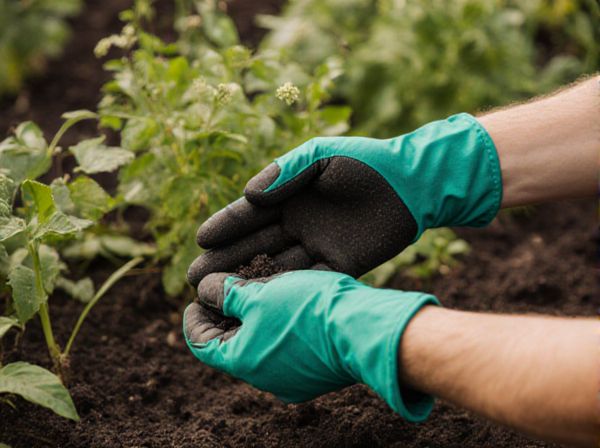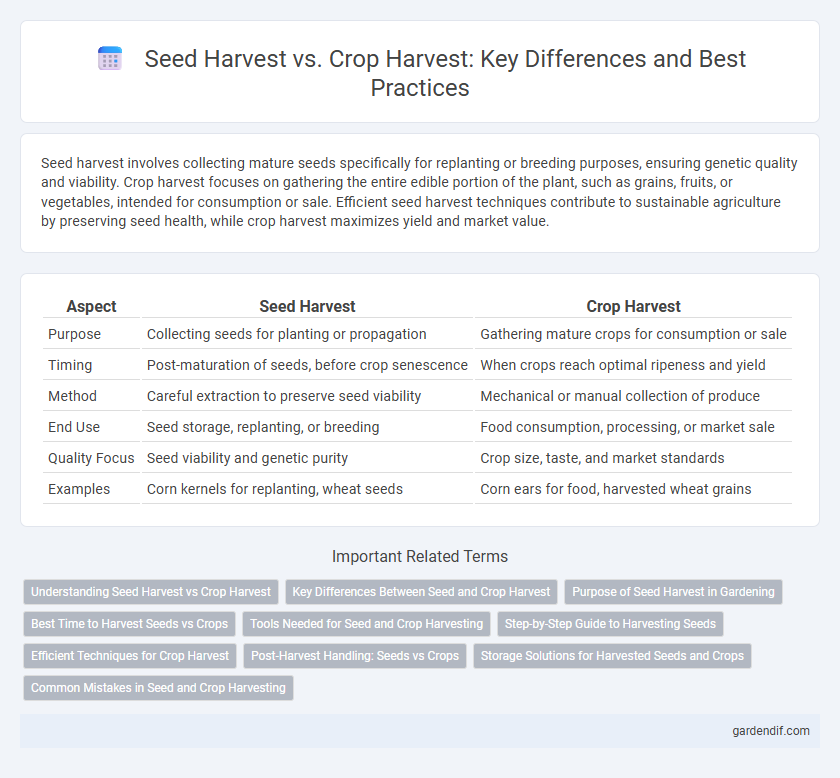
Seed Harvest vs Crop Harvest Illustration
Seed harvest involves collecting mature seeds specifically for replanting or breeding purposes, ensuring genetic quality and viability. Crop harvest focuses on gathering the entire edible portion of the plant, such as grains, fruits, or vegetables, intended for consumption or sale. Efficient seed harvest techniques contribute to sustainable agriculture by preserving seed health, while crop harvest maximizes yield and market value.
Table of Comparison
| Aspect | Seed Harvest | Crop Harvest |
|---|---|---|
| Purpose | Collecting seeds for planting or propagation | Gathering mature crops for consumption or sale |
| Timing | Post-maturation of seeds, before crop senescence | When crops reach optimal ripeness and yield |
| Method | Careful extraction to preserve seed viability | Mechanical or manual collection of produce |
| End Use | Seed storage, replanting, or breeding | Food consumption, processing, or market sale |
| Quality Focus | Seed viability and genetic purity | Crop size, taste, and market standards |
| Examples | Corn kernels for replanting, wheat seeds | Corn ears for food, harvested wheat grains |
Understanding Seed Harvest vs Crop Harvest
Seed harvest focuses on collecting mature seeds specifically for reproduction and future planting, ensuring genetic quality and viability. Crop harvest involves gathering the entire plant parts, such as grains, fruits, or vegetables, intended for immediate consumption or sale. Understanding the distinction helps optimize harvesting methods and post-harvest handling to maximize yield and maintain seed integrity.
Key Differences Between Seed and Crop Harvest
Seed harvest focuses on collecting mature seeds for propagation and future planting, emphasizing seed viability and purity, while crop harvest targets the entire plant or its edible parts for immediate consumption or sale. Seed harvesting requires precise timing to ensure seeds are fully developed and properly dried, contrasting with crop harvesting, which prioritizes maximizing yield and quality of produce. Equipment and techniques also differ, with seed harvest often involving specialized seed cleaners and storage methods to maintain seed quality.
Purpose of Seed Harvest in Gardening
Seed harvest in gardening primarily focuses on collecting mature seeds to ensure future plant propagation and genetic preservation, unlike crop harvest which targets edible or marketable produce. The purpose of seed harvesting is to maintain plant biodiversity, support sustainable gardening practices, and provide gardeners with high-quality seeds for the next growing season. Proper timing and handling during seed harvest are crucial to maximize seed viability and germination rates.
Best Time to Harvest Seeds vs Crops
The best time to harvest seeds is when they are fully mature, dry, and hard to ensure maximum viability and germination rates, often indicated by a change in color and dryness of the seed pod. In contrast, crop harvest timing depends on the intended use, typically when fruits or vegetables reach peak ripeness and flavor, which varies by species and climate conditions. Monitoring moisture content and environmental factors is crucial for both seed and crop harvests to optimize quality and yield.
Tools Needed for Seed and Crop Harvesting
Seed harvesting requires specialized tools like seed cleaners, threshers, and seed drills to efficiently separate and collect viable seeds while minimizing damage. Crop harvesting benefits from combines, reapers, and mechanical harvesters designed to gather mature crops quickly and reduce post-harvest losses. Both processes also rely on storage containers and moisture meters to ensure seed viability and crop quality during handling and storage.
Step-by-Step Guide to Harvesting Seeds
Seed harvesting begins with selecting mature, disease-free plants to ensure high-quality seeds. After cutting the seed heads, dry them thoroughly in a well-ventilated area to prevent mold and facilitate seed separation. Finally, thresh the dried seed heads to extract the seeds, clean them with sieves or screens, and store in airtight containers in a cool, dark place for optimal germination.
Efficient Techniques for Crop Harvest
Efficient crop harvest techniques focus on mechanization and precision agriculture to maximize yield while minimizing waste and labor costs. Methods such as combine harvesters and GPS-guided machinery ensure timely and uniform crop collection, reducing grain loss and enhancing productivity. Implementing moisture sensors and automated sorting systems optimizes post-harvest quality control, further improving overall efficiency in crop harvesting.
Post-Harvest Handling: Seeds vs Crops
Post-harvest handling of seeds involves careful drying, cleaning, and storage to maintain viability and prevent fungal growth, ensuring optimal germination rates. Crop harvest post-processing prioritizes moisture reduction, sorting, and packaging to preserve freshness, nutritional quality, and extend shelf life for market distribution. Seed handling demands stricter control of environmental factors like temperature and humidity compared to crop handling, highlighting the critical differences in post-harvest management practices.
Storage Solutions for Harvested Seeds and Crops
Effective storage solutions for harvested seeds require controlled environments with low moisture and stable temperatures to maintain seed viability and prevent fungal growth. Crop harvest storage emphasizes bulk handling systems such as silos and granaries with aeration to reduce spoilage and insect infestation during prolonged storage. Optimal storage techniques for seeds and crops utilize moisture-proof containers and climate control technologies to maximize longevity and preserve nutritional quality.
Common Mistakes in Seed and Crop Harvesting
Common mistakes in seed harvest include premature collection, leading to low germination rates, and moisture mismanagement, which causes seed spoilage or mold growth. Crop harvest errors often involve delayed harvesting, resulting in decreased yield quality and increased vulnerability to pests and diseases. Proper timing and careful handling are essential to maximize both seed viability and overall crop productivity.
Seed Harvest vs Crop Harvest Infographic

 gardendif.com
gardendif.com